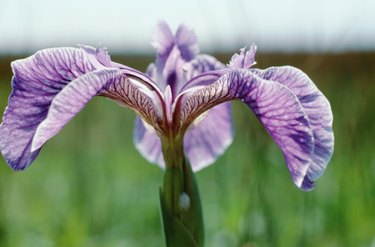
Irises are a favorite perennial for gardeners for their wide variety of colors and the beautiful contribution their flowers make to landscapes. You have your choice between bearded, beardless and aril irises to grow. Make sure you plant your irises after the last frost in the early spring, so that the flower can bloom in the summer months.
When to Dig Up Iris Bulbs
Video of the Day
Start deadheading your irises after they bloom, but allow their foliage to grow. Use a pair of bypass shears to gently cut off their old blooms. As their foliage begins to discolor and brown, cut it off at the base of the plant. Make a note where and what type of bulbs you have planted in your yard. When it is time to dig them up, it can be almost impossible to determine what type of bulb you have planted in the ground. You can either place a small label near the plants or make a diagram of your flower garden with each plant's location and information. Dig up your iris bulbs one to two months after their blooming season. Pick a time in July or August to dig up your irises. Waiting after these months can result in the iris establishing a strong root system that will make it susceptible to being pushed out of the ground from the natural freezing and thawing cycles during winter.
Video of the Day
How to Dig Up Iris Bulbs
Start your hole a few inches away from your iris plants to avoid harming them. Make sure your shovel goes six to eight inches into the ground. Tilt the shovel to gently push up the iris bulbs. If you feel like you may be harming your bulbs, use your hand to brush away the soil. Trim any remaining leaves to divert the water to the rhizome. Wash your rhizome off with a garden hose, so you can inspect it for any damage or root rot. With a sharp knife, cut off any areas that look mushy or indicate root rot. Dip the knife in a mixture of 70 percent denatured alcohol and 30 percent water to avoid spreading any diseases. Dry off the rhizome for storage.
Other Resons to Dig Up Irises
Fungal diseases like rust, didlymellina leaf spots, iris borers and bacterial leaf spots can infect your irises. Look for reddish brown leaves, red pustules and black rot on rhizomes. Prune away the damaged areas and apply a fungicide. If the damage is too great on the iris, you should dig it up to prevent the plant from infecting the rest of your flower bed. Because fungal spores quickly spread through the wind, make sure that you remove any leaves or flower buds with the disease from the area.